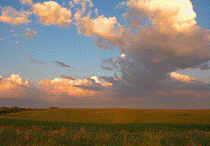North American Prairie Conference
Date of this Version
1989
Abstract
The Nebraska Sandhills is the largest area of sand dunes in the Western Hemisphere, occupying over 5 million ha in northcentral Nebraska. The rolling to steep dunes range in height from a few meters to over 60 m. Soils are poorly developed in wind deposited sand. The continental climate is characterized by 425 to 625 mm of annual precipitation, an average annual temperature of 10 C, and a frost-free period of 130-155 days. Upland vegetation is primarily tall grasses and midgrasses such as sand bluestem [Andropogon gerardii var. paucipilus (Nash) Fern.], prairie sandreed [CaLamovilfa Longifolia (Hook.) Scribn.], little bluestem [Schizachyrium scoparium (Michx.) Nash], and switchgrass (Panicum virgatum L.). Forbs are common. Wind erosion occurs when the protective cover of vegetation is destroyed. Blowouts are active sites of erosion. Blowouts are irregular or conical craters formed when the deep, loose sands are removed by swirling action of the prevailing northwesterly winds. Blowout penstemon (Penstemon haydenii S. Wats.) is only found on these sites of active wind erosion and is an early successional species. Important associated species in blowouts include blowout grass [Redfieldia flexuosa (Thurb.) Vasey] and lemon scurfpea (Psoralea Lanceolata Pursh). The number of blowouts has decreased with the control of fire and improved range management techniques. Loss of suitable habitat is one of the reasons for the decline of blowout penstemon. At the same time, there are many blowouts in the Sandhills that seem to offer suitable habitat where blowout penstemon is not found.


Comments
Published in Prairie Pioneers: Ecology, History and Culture: Proceedings of the Eleventh North American Prairie Conference, August 7-11, 1988, Lincoln, Nebraska (Lincoln, NE 1989).